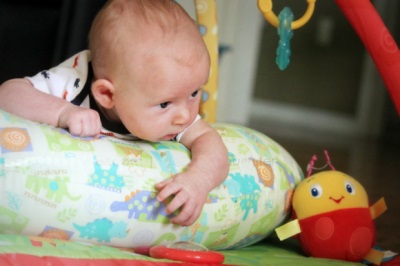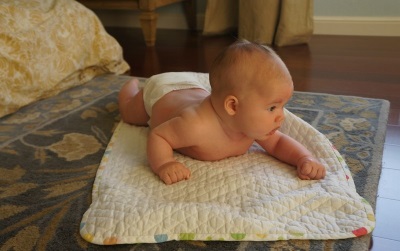When does a baby start keeping its head on its own?
Holding the baby's head is the first motor skill that babies master after birth. Every mother is waiting for him with impatience and begins to worry if in all terms the child should already keep her head well, but the crumbs are not yet working. At what age is the child normally supposed to master such a skill and what should parents do if the kid at this age still has difficulty keeping his head?
Skill development
Newborn babies cannot control their neck muscles, so babies in the first month of life are unable to hold their head. Their movements are reflexive, and if you raise the crumbs for hands, the baby's head will fall back, which threatens to damage the vertebrae. That is why, until the moment when the baby learns to keep its head on its own for a long time, adults should support the crumb for the back of the head.
The development of the skill of holding the head is as follows:
- In the second or third week of life, while laying out on the tummy, the crumb begins to try to raise its head.
- In the second month of life, the child is able to raise his head in the prone position (the head is at an acute angle) and is able to hold it for 30-60 seconds.
- In the third month of life, the baby is already holding his head upright, but the neck muscles have not yet fully strengthened, so adults should still insure a baby. In position on the belly, the baby already lifts both the head and the shoulder girdle, and if the baby’s body is raised from the position on the back, pulling the child by the arms, the head with the neck remains in one line.
- In the fourth or fifth month of life, the child already holds his head well enough and turns it to the sides.
At what age can children keep their heads themselves?
Most healthy children learn to hold their heads to 3 months of age. Some of the babies master this skill even in 2 months, and someone needs to take a little more time to master it and such kids learn well only by 4 months.
Norms for premature babies
Early-born babies begin to hold their heads from two to three months of age. Only in the second month of life, such babies begin to try to keep the head in a position on the stomach, but they quickly get tired of such efforts. At 4 months of age, many premature babies have held their heads for some time.

Deviations from the norm
Baby keeps his head in 1 month
Too early retention of the head, which can be observed in a child aged 4-6 weeks, is a sign of increased intracranial pressure, hypertonia of the neck muscles or some other neurological problems. So, if the child is a month old and he is already holding his head, you should show the baby to the pediatrician for the purpose of examination, special massage and treatment.

At 3 months, the baby, lying on his stomach, does not hold his head
This situation may be due to:
- Prematurity of the child.
- Postponed birth injury.
- Weak muscle tone.
- Torture (with such a problem, the child can not keep his head straight).
- Bad weight gain. Verify this reason will help control weighing.
- Rare vykladyvaniem on the stomach, or even the absence of layouts in the first months of life.
We carry out the test at home
To check the child's ability to hold his head, you need to lay a crumb on the back, then take it by the handles and gently pull it to the crumb. If the child keeps his head straight for 30 seconds, then everything is in order with this development indicator. In this case, the baby's head can swing.
Then again, put the baby on the back, take the baby by the handles and slightly raise so that the baby hangs. With the normal development of the retention skill, the baby’s head remains on the spine line for 2 seconds after lifting, and only then it tilts.
Lag action
The first action of a mother who doubts the normal development of this skill should be a visit to a pediatrician. You need to tell the doctor about the alarming symptoms, after which the pediatrician will examine the baby and direct the baby to a neurologist, as well as for additional examinations. The doctor may prescribe various neurological tests and CT scans.
After the results of the examination, the child is prescribed the necessary medicines and prescribed local procedures. If a neurological pathology was detected, treatment should begin as soon as possible, then its result will manifest itself more quickly.
If the mother doubts the appointment of a doctor, you should contact another specialist. It is important to remember that it is impossible to independently massage a child with problems of the nervous system. It is better to contact a certified massage therapist and undergo a course of massage. At home with the baby, you can perform special exercises that are advised by a neurologist.
Exercises to strengthen the muscles of the neck
- Start spreading the crumb on the tummy as soon as the umbilical wound has healed. This is usually done before a meal for a few minutes, gradually increasing the duration. A stay on the abdomen contributes to mastering the skill of holding the head.
- Wear the baby in your arms in a position on the tummy. With one hand hold the head of the toddler, the second place under the belly of the baby. So you will stimulate the desire of the baby to consider everything around and hold for this head.
- As soon as the child has learned to hold his head for at least a few seconds, carry the baby upright, supporting the back of the head with the fingers.
- Take the child in your arms so that one of your hands holds the crumb under the breast, and the other is under the legs of the baby. The child’s face will be pointing down. Raise the toddler into the air and lower it down, and also arrange the “swing” for the baby - in turn, raise his pelvis and then his head.
- Roll the child on fitball. Let mom hold the baby by the handles, and dad holds the pelvis. Together you need to gently swing the crumb back and forth and sideways.
- Play with the child with the sound source. Attract the attention of the baby with music or a rattle so that the crumb turned his head toward the sound and at the same time trained the muscles of the neck.

Massage and nutrition
If the baby has no neurological problems, massage for the crumbs is done at home with the help of stroking and rubbing movements. Mom should stroke the child's arms, belly, back, legs.
Experts note that nutrition plays an important role in the motor development of an infant. If the baby is breastfeeding, then the mother should pay attention to your diet. The menu of the nursing mother should be balanced in calories and nutrients, as well as include sources of minerals and vitamins.If the diet is monotonous, you should think about additional intake of vitamin complexes.
Tips
- If the child does not like laying out on the stomach, you should not refuse such an exercise, because it is extremely important for the development of the baby. Choose a time when the child is satisfied and calm. For distraction, you can use a bright toy, a pleasant song, affectionate stroking. And most importantly - the baby on the tummy can not be left alone in any case.
- Sign up with a baby in the children's pool and regularly visit it with the baby. Swimming helps not only to strengthen muscles and develop motor skills, but also has a positive effect on the emotional sphere.

















